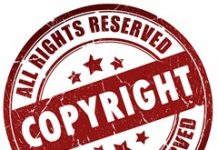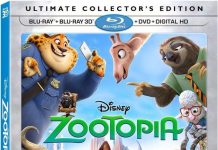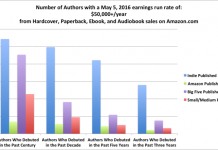
There are huge debates going on in the eBook world about the appropriate price points for online books, and the opinions differ, so it gets a bit messy given that books now range from free and up, with 99 cents and $2.99 becoming very common both for fiction and nonfiction, but if you check the top 100 of both categories you will see that pricing is all over the map with some very strange price points, like $7.40. There’s a lot of experimenting going on with some authors thinking 99 cents is the Holy Grail toward profit while others pick a price like $17.54 for books that aren’t really differentiated to explain the price differential.
In essence, what the eBook market will eventually come up against is something called pricing anchors; these are the prices that consumers normally associate with any product or service. In paper books, readers have long been conditioned to prices in the range of $15.95-$19.95 for paperbacks and $28.95 and up for hardcover books.
For decades, if publishers priced books significantly higher than the expected anchor prices, they had to be able to convince buyers that the books were something special. Conversely, if the price on a hardcover dropped below $20, or if you found a paperback at $9.95, they were seen as being truly “on sale” and thus good deals. Everyone knew what the price anchors were.
That’s all out the window now with some eBook prices being “free!” We’re in the first inning of a process of book pricing that will take some time to work through.
So, the game has changed; what is the best price for an eBook: 99 cents, $2.99, $4.99 or $9.99? People say to experiment with different prices to see what works best, but if you intend to experiment, you have to start high and work down because chances are you won’t be able to increase your price. It’s smart to charge as much as possible, of course.
On a personal note, I hate to see hard-working authors being valued below $3. We now function as researchers, writers, marketers, and administrators—there’s a lot to know and a lot to do to self publish.
We still get what we pay for
I’ve talked to several dozen people about pricing, and there’s a general feeling that something is still worth what you pay for it. Most people think free or 99-cent books have little or no value and must be written by amateurs or desperate people. Sure, the John Locke’s and Amanda Hocking’s can make money because they have established names and can take a small chunk of a million books and still do fine. But too cheap can work against you, too.
There’s a ton of research available on price theory that is instructive. For example, we’ve all seen products priced at what are called “charm prices” or numbers slightly below an even number: $2.59, $2.79, $2.95, $2.98, or $2.99. Perhaps you’ve wondered what the psychological underpinnings were for the different decisions.
Kaushik Basu, chief economist to the government of India, performed game theory research which revealed that buyers’ decisions are not materially affected by the “cents” part of any purchase. He found that since people read numbers from left to right, a left-digit blindness effect causes us to not read the last two digits, so we mentally see $4.99 as $4.00. So, according to Basu, you might as well charge the maximum cents, i.e. $4.99 instead of $4.29 because there won’t be noticeably more buyers at the lower price anyway.
If something is priced below $10, people round downward between $1-$10, but as soon as the price tops $10, the rounding moves to $10-$20, and a whole different attitude sets in about relative value. With prices of $26.99 or $29.99, you’ll see no real difference in sales. Pop the price to $30.29 and suddenly the rounding is $30-$40, and there will be buyer resistance.
When I worked with the educational publishing house, EduServ Inc., we priced books from $29.95 to $99.95 and justified the difference based on perceived life or death value—really. For example, a book offering advice to teachers on how to get better results in the classroom would warrant the $29.95 price, but one on school bus driver training, or another on how to draft AIDS policies in school districts sold extremely well at $99.95 because of the perceptions among school district administrators and elected officials that there was information that was badly needed and that literally affected people’s lives (or deaths). We never had one of those returned!
The big royalty debate
The standard royalty levels, as set by Amazon and Barnes & Noble (and they are the determiners), dictate that e-authors are paid different royalties based on retail prices. If your book sells for $3-$9.99 you receive 65% from B&N and 70% from Kindle, if it sells for less than $3 or more than $9.99, you receive 35%.
There’s a lot of support now for works of fiction priced from 99 cents to $2.99, but this price point puts you in the 35% royalty range, whereas $2.99-$9.99 warrants royalties of 65-70%. Yes there are some deductions from those high percentages, territory restrictions, download fees, etc., but even if those fees erode the 65-70% down to 35%, I’ll take 35% of $4.99 any day over 35% of $2.99. I believe that reader psychology is important here, i.e. if you market your book properly, i.e. position it well so it’s seen as truly valuable, and more so than your competitors, you can charge more.
If you use an aggregator to get your eBook into the format required by Amazon or B&N, then you will be subject to upfront charges, plus other fees as may be applicable for the work they perform on your behalf, often 10%-15% of the author’s portion. So, if you sell a book at $4.99 and get 65% from B&N = $3.24, less the aggregator’s 15% cut = $2.76 to you.
I don’t have a problem with eBooks being less expensive than paper, after all there is no physical product to print, ship, or warehouse, so pricing from $4.99-$9.99 as compared to $15.95-$19.95 for a print book seems reasonable. And, you stand to make far more than you would with the old legacy publisher system where you received 10% on retail.
I have to think that the entertainment value of a good fiction read, or the practical advice received from a work on nonfiction is worth the price of a cocktail. The ease of being able to upload books for free to Amazon, B&N and others may actually be encouraging a lot of people who aren’t really writers at all and who can then afford to just stroke their vanity. I’d have no problem paying a fee to upload. Serious writers would only benefit if some way can be found to discourage some of the awful hacks that upload material so badly written and conceived that it reflects badly on all self pubbers…I may regret having written that!
[Via the Ebook Author blog]


































In paper books, readers have long been conditioned to prices in the range of $15.95-$19.95 for paperbacks and $28.95 and up for hardcover books.
In what universe do paperbacks start at $15.95?
Only trade paper are real books? And even trade paper is only a real book when it’s bought at full retail in stand alone bookstores?
Genre MMP (which mostly maxs at $8 with a few top selling authors in slightly taller MMP at $10) sells vastly more paper books than trade paper does. And vastly more MMP ebook editions than trade paper ebook editions.
Genre fiction is driving the sales of ereaders and the price of ebooks. Not trade paper.
This article clarifies why I don’t want to release my fiction novel ‘Chasing the Will’ in April 2012 at 99cents. My labor of love is worth more than less than a dollar. I was going to start at $4.99 or $5.99 and I believe you’ve confirmed my choice is right; but if no-one buys and I can sell a half million at 99c, I’ll back-track!
I have to agree with Vicki — I have NEVER paid $15.95 for a mass market paperback, although I have paid more than that for a self-published specialty book written by a friend and that I helped edit and have my name on the back with a mini-review and it’s signed by the author. But I think that’s the only paperback book I ever paid that much for. Most of them are in the $6.99 – 8.99 range. (I buy 99% of my books on Amazon)
The list price on my only self-pubbed print book (memoire, on another pen name) is $14.95 but it sells for far less than that (I sell the copies I bought for $12 or less; the print cost through lulu was about $7.50 per book). I was required to list it for at least double the print cost so retailers could “discount” it. I get about $4.50 per copy as royalty but there have been almost no sales in print. It’s out there as an ebook for $6.99 and I get the same royalty per copy as the print book and I’m getting a trickle of sales now. I don’t promote it anywhere at all.
The ebook (mystery novel) I published under this pen name is out there for $2.99 and I’ve made about $100+ in royalties since November with no promotion at all other than the Kindle freebie promotion a couple weeks ago that moved 1500 free copies and gave me about 40 paid sales since due to Amazon suggestions. Not what I was hoping for, but it’s $100 I didn’t have before and was little effort for me to get it. And I’m learning.
This is an important subject and an insightful article and I’m kind of holding back any self-promotions until I can digest the information out there and decide what the best approach is. I have a third book waiting in the wings (PI novel) that I think has more saleability and market appeal than the other two so I want to be better informed before I decide where and how and at what price to publish that one.
Dear Mr. Bareham:
I enjoyed your blog. I have worked for over six years writing book after book, having the query rejected by so many I quit counting. A friend finally discussed with me the opportunity to publish in the E-Book fashion. I reworked one of my novel for over a year, writing and rewriting until I and another person well trained in English and punctuation. Finally is was ready. I rewrote the novel six more times after the first draft to the self publishing company. I feel that pricing that book at 99cents would have been a disaster. I priced it at the top price, 9.99 and I’m proud I did. I don’t know what may come of it, but I am going to work awfully hard to market it myself. The books first chapter is featured in my web site. The name is Bottom Bones, a detective mystery with Frank Hawthorn.
Thanks for addressing the pricing situation. I think you are right.
Sincerely,
James M. Copeland
I think the 2.99 – 9.99 markers are INCLUSIVE aren’t they? I Have authors selling at $2.99 and they DO get the 70% royalty (though 30% of that goes into the US withholding tax when I actually get paid.)
You don’t have to pay the withholding tax if you fill out the tax treaty forms. They might look difficult, but take a little time and they become quite obvious. It’s worth it for the 30%, although you can set it against tax paid in another tax treaty country.
Dear Mr. Bareham:
I am unawear of any taxing situation. The people I have my work with have not asked for any tax information?
James M. Copeland
@James; are you in the country where you are selling books – that would explain it? Amazon and some others insist on the withholding tax. Others that don’t leave it up to you!
Hi folks: Okay, a few things to answer for:
Vicki: I’m from Canada, so paperback prices here were always much higher than in the U.S., i.e. several dollars higher, and that’s the world I’ve always lived in. We Canucks have always been jealous of the less expensive books Americans have been able to enjoy. We’ve traditionally expected to pay $16+ for fiction paperbacks and more for how-to paperbacks. Now that our dollar is at par, things are better, but we’re still higher than the U.S.
Mr. Copeland: right you are on your book. Insofar as the withholding tax situation is concerned, the 30% must be withheld by U.S. aggregators until a Canadian, or other nationality I assume, fills out the necessary paperwork, and that can take months to clear. However, companies such as BookBaby hold back nothing since they take none of your royalties and serve simply as a flow through; amazing service really and I love their corporate philosophy. I had/have no desire to get into any wrangles with the IRS, so I’ll not be going down that road with U.S. book sales.
As a reader, my “sweet spot” for buying a digital book is between $3-8, with the top price being only for a trusted author. Generally, for a new author, I will try a sample, then if I really like it–and the price is under $5–I’ll give it a try. If the price is higher, I’ll keep the sample for a while, reread and rethink it. If I still like it, then I’ll probably buy it later. If it doesn’t grab me again, then its delete time.
I grab a lot of free digital books and so far, have found one that I liked well enough to go look at the author’s backlist. I bought two books from the backlist. I still have a lot of freebies to go through. Usually, I’ll just take a few hours and do a fast assessment to weed out my ereader. I start reading and if the story or writing doesn’t grab me fast, then its delete time.
Authors that I liked who were trad published and now indie publishing, I will watch and sometimes buy, though I have noticed that they tend to price on the high side. If the book is new, no problem, but if its something I read and wouldn’t mind having in digital–yeah, don’t like that. (Find it outrageous what trad publishers are charging for backlist release, btw. But then most of trad NY pub prices tick me off – grin)
The thing that keeps me with my small press, and using a more traditional model, is the lack of polish I see in so many of the free/.99 books that I’ve picked up so far. (I have not read all, of course, and I fish in a pretty narrow genre pond.) For me, having an editor is an important part of my writing process. I know there are indie authors who use editors. And I’m totally behind indie efforts and have been for years. I admire those who can handle all the work and detail of indie publishing.
I am also aware that what is for me “a lack of polish” is love at first sight for someone else. How one connects with a book is highly personal. That’s what makes the book business so interesting and so challenging. There are tons of NY bestsellers that I totally failed to connect with.
But what is happened is that I don’t impulse buy anymore. I sample. And then I think about it, because there have been a few books I sampled and then didn’t like as I got deeper into the books. So I also read the reader comments and any reviews.
No surprise that a recommendation from someone I trust can tip the scales toward a buy click. Word of mouth is still strong in my world. And its ONLY way I *might* pay 9.99 for a digital book.
What I do, if I really want a book and it is priced too high is just wait and watch for a cheap used edition to pop up. Or I move on. I’ve also been known to set price drop alerts on ereaderiq.com. But for the most part, the most expensive digital releases can’t even be shared once. So, no. Won’t play in that paradigm.
I feel bad buying used, but I have to look out for my budget and bottom line. Authors are looking out for THEIR bottom line when they choose their manner of publication. IMHO of course. 🙂